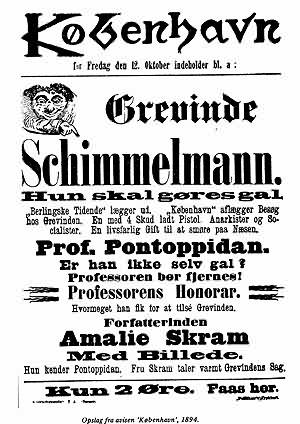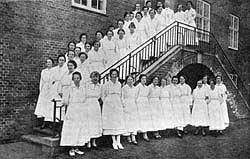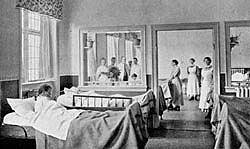
„Patients confined to beds used as a
treatment. Ward round at the so called
“Treatment House” at
St. Hans Hospital, 1916
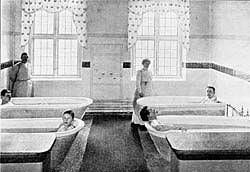
„“Waterbed Treatment”: Ward for
prolonged baths. St. Hans Hospital, 1916
The Asylum – an isolated environment
From around 1900 the big asylums stood, with their massive brick walls, in remote and scenic areas, as kinds of impregnable fortresses. Both patients and doctors operated in an isolated environment, where the consultant psychiatrists were the undisputed authority. Strict rules and overcrowding could lead to humiliating treatment of the patients, who were effectively declared incapable of managing their own affairs.
Behind the thick walls of the asylums
At the beginning of the 1900s the supervising staff were still poorly educated. An actual carers’ training was not implemented until around World War 1: ”… One of the patients was very filthy and when he had to be washed the carers put him into a rusty tub with cold water and scrubbed him with a broom …”. (A warden’s account from the beginning of the 1900s).
Psychiatry as a specialty
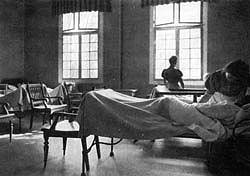
Monitored room for restless women
at the Municipal hospital ward no. 6
(the beginning of 1900s). It was to this
ward that Amalie Skram was first
admitted. Later, she was
transferred to St. Hans Hospital.
In 1875 a ward for mental illnesses, called Ward no. 6, was opened at the Copenhagen Municipal Hospital. A place that, from the beginning ,was either infamous or disreputable. The ward became an educational ward under The University of Copenhagen. The Consultant Psychiatrist of the ward was appointed the position as Professor. The first professor (appointed in 1887) was Knud Pontoppidan.
Psychiatry was about to be officially recognized as a specialty in medical science.
The first anti-psychiatric rebellion in 1895
In 1895 the previously mentioned ward no. 6 became the setting of the first anti-psychiatric rebellion against the established asylum psychiatry. The feud, which could not quite free itself from being a personal feud, was a clash between two highly talented and highly educated personalities, the writer Amalie Skram and Dr. Knud Pontoppidan. They each had their own view of the case and therefore wrote their own individual report. Amalie Skram: “Professor Hieronimus” and Knud Pontoppidan: “Elegy of Ward no. 6”.
The feud also revealed a clash between two strong personalities. They both needed to be noticed. Amalie Skram was known for her social protest. She was a supporter of the freethinker called Brandes and she was a supporter of women’s liberation.
The opponents in the feud were the doctors who represented the newly developed asylum psychiatry. Their scientific authority allowed them to decide whether or not a patient was considered uncontrollable. It also allowed them to specify the need for orderly and strict regulation.
The press learned about the matter from some gossip amongst the upper classes. Dr. Knud Pontoppidan who was actually a great reformer of Danish psychiatry, ended up withdrawing from the feud. He saw Amalie Skram’s criticism as an attack on psychiatry as a whole.
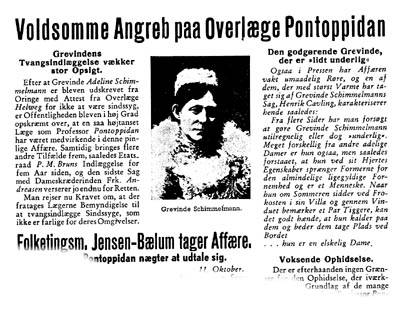
The healing bed rest
In 1898, Knud Pontoppidan became the Consultant of the Lunatic Asylum outside Århus. In his short stay at the asylum he launched several reforms. The praxis of using isolation cells was abandoned. These he had previously abolished at ward no. 6 at the Municipal Hospital in Copenhagen. The wards were opened up so now there was access to the park directly from the wards. Instead of the cells, bed rest was now used as a curative measure. In large monitored wards, patients were put to bed upon admittance and they were to stay there for quite a long time. In case of a patient getting agitated he could be secured to the bed by straps.
Female nurses from around 1900
Pontoppidan began employing trained female nurses at the wards for disruptive male patients. It was first implemented at Ward no.6 at Copenhagen Municipal Hospital and later on at Jutland Asylum. This was a lasting reform that led to more peace and civil behaviour at these wards. The first nurses were mostly women of the higher classes.




